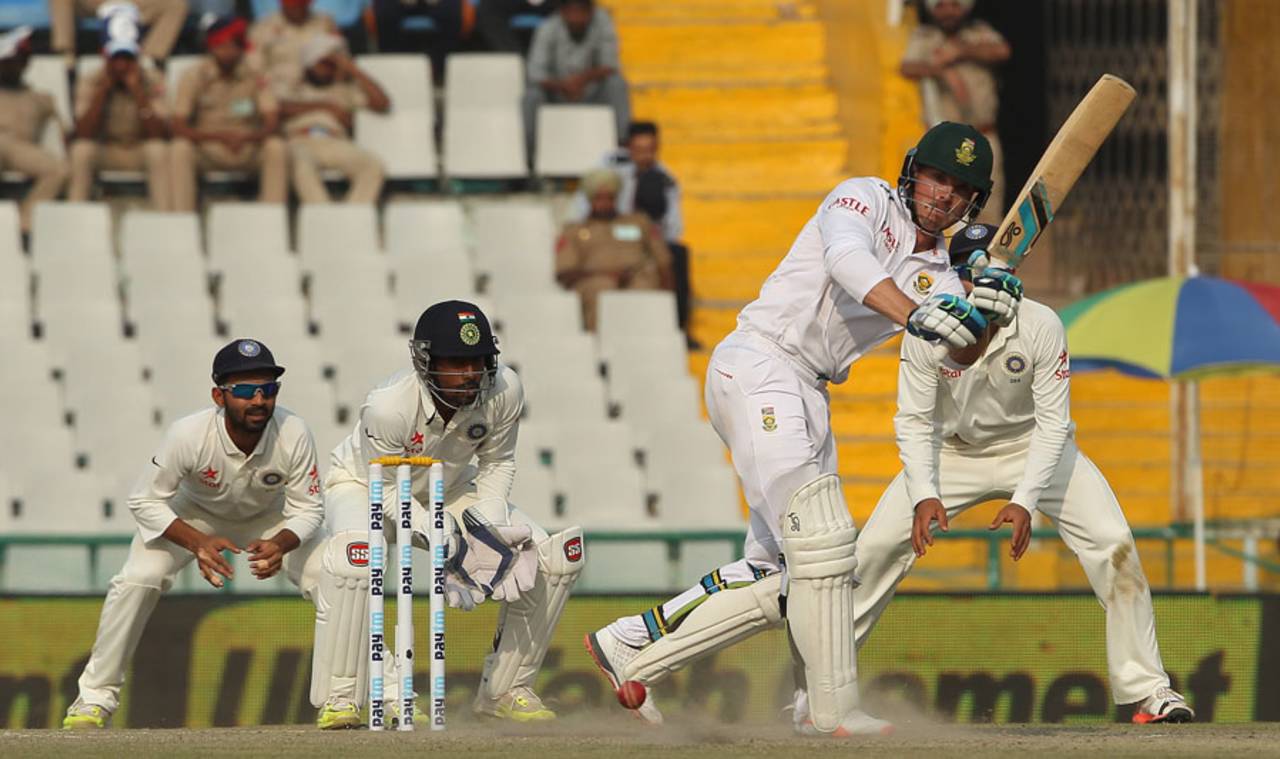The sun was just starting to splash its way across the Nagpur sky on what would have been the fourth day of the Test between India and South Africa, when four of the city's cricketers, with no game to watch, started a training session instead. At the Dr Ambedkar College's Sports Academy, with the Deekshabhoomi monument as his backdrop, one batsman geared up to face a slew of spin.
His three compatriots took turns taking a few casual steps in and twirling the ball towards him. He watched, he waited, he lunged forward and then, he dead-batted the ball back to them over and over, as though the sole purpose of the practice was to be as stubborn as possible. Scoring was not an option in the situation anyway, but you got the feeling that even if the netting was not there, he would have approached things in exactly the same way.
The South Africa players, who are still in Nagpur for another two days before they make their way to Delhi, may have been interested observers had they ventured to that side of the city. Not because it would have showed them a possible strategy for neutralising the spin threat - they already figured that out on the day they lost the match when
Hashim Amla and
Faf du Plessis stood their ground for seven minutes short of three hours - but to see how early and how earnestly the mastering of the art begins.
For those youngsters, spin bowling and defensive batting was the only task of the day. Perhaps they had done work against quicks earlier in the week, perhaps they were going to get to the pull shot and the expansive drive later in the day. Whatever the rest of their agenda was, the fact that those kids were trying to perfect an art that even international cricketers still struggle with, spoke volumes.
It is not outlandish to suggest foreign players go for an exchange in the Ranji Trophy, just as they do in the county circuit. They already spend time in the Indian domestic circuit during the IPL, but as Amla, pointed out, that does not really help when it comes to Tests
It is an accepted practice across sport that the hosts will have a little something more on their side than the visitors. That is what makes winning away so special, and so rare. But there may be a point where the hosts prefer to be less disadvantaged. There may be a point where the hosts stop making conditions tough for everyone and a little less hard for themselves, something South Africa have subtly accused India of doing on this tour.
The rights and wrongs of that have been debated, but a solution has not been sourced yet. How does a team like South Africa, who do not often see wickets as worn as the ones they played on here, or a team like India, who do not play on pitches with the pace and bounce of Johannesburg, learn to deal with them at the highest level? The answer may lie in what the quartet at the college academy were doing: start young.
South Africa already hold an annual spinners' camp in India, where they send promising bowlers and batsmen from the franchise and provincial set-up, but maybe they can start even younger than that. Why not send Under-19 players, or even a selection of the best schoolboys? And ten days is too short a time to actually learn something. Why not a whole season?
It is not outlandish to suggest foreign players go for an exchange in the Ranji Trophy, just as they do in the county circuit. They already spend time in the Indian domestic circuit during the IPL, but as Amla, pointed out, that does not really help when it comes to Tests. First-class cricket is where future internationals are bred, not the kind of contests that see South Africa A play two unofficial Tests.
Just imagine if
Stiaan van Zyl or
Dane Vilas had spent some time in the Ranji trophy for a few weeks before being given the job of opening the batting on their first senior tour to India. They would certainly have learnt about the extent of the spin they would be confronted with.
The pitches in India have been so extreme that even Rahul Dravid
criticised the conditions saying they were "no good for the health of Indian cricket." Even if that is the case - and it might be when it comes to the Indian batsmen's capabilities of constructing innings over long periods of time - they raised the curtain for the international surfaces India were planning to prepare.
The same can apply in reverse. South Africa's first-class competition is closely contested. In most seasons, there are spirited performances from up and coming seamers and there is a good blend of older statesmen providing stability. A player from the subcontinent would learn a significant amount about bounce there.
India could do worse than sending a few of their players there soon. Even though South Africa are only due to host India again in the summer of 2017-18 according to the
most recent draft of the FTP, that is not long enough for them to forget what India served them on this trip. South Africa will no doubt plan to get their own advantage back. But proper planning could be the best way to prevent that from happening, and to negate the kind of home advantage that is threatening to blunt competitiveness from cricket.
Firdose Moonda is ESPNcricinfo's South Africa correspondent
